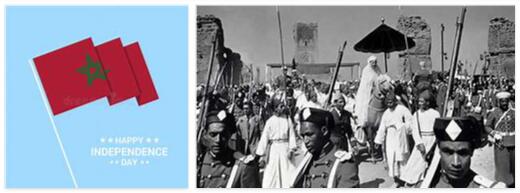From its origins to independence
The most remote traces of human life date back to a certainly very ancient phase of the lower Paleolithic. The stratigraphic sequence of Sidi ‛Abd ar-Rahman, near Casablanca, embraces a series of cultures starting from the pebble culture to the Acheulean, and its chronological interpretation was proposed on the basis of the succession of the different Quaternary sea shore lines. The existence of a true Mousterian has been proven by some studies in the Cave of the Pigeons of Taforalt and at the Jebel Irhoud. The diffusion of the Aterian (before 30,000 years ago) in Morocco has long been known, and there are also the deposits in which the subsequent Iberomaurusian culture is attested (20,000-7000 BC). The Moroccan Neolithic variant of the Capsian tradition seems to have lasted quite a long time; in Dar es-Soltan some elements have also been found that recall the European bell-shaped vase complexes (glass similar to the typical one, archer’s bracelet). The country from the end of the second millennium BC it maintained relations with the Phoenician navigators, which intensified after the rise of Carthage (6th century).
In the 4th century. BC the indigenous kingdom of Mauretania was formed, which stretched from the ocean to the Mulucha river (Muluia) and lasted until the Roman annexation following the killing of the last king Ptolemy (40 AD) becoming, in 42, the province of Mauretania Tingitana. Of the Roman dominion, which lasted 4 centuries, the ruins of Volubilis and Sala remain. After the Vandal invasion (5th century) and the partial Byzantine reconquest, Morocco was occupied by the Arabs (7th-8th century). After a first autonomous state formation under the Idrisites, a period followed in which the Morocco was disputed between the Umayyads of Spain and the Fatimids of Tunisia. and Egypt. Then came the two great Berber empires of the Almoravids and Almohads (11th-12th century) which represented the period of greatest power in Morocco. With the fall of the Almohads, Moroccan history resumed a regional character; there ruled the Merinids (13 ° -15 ° sec.) and wattasid dynasty (15 ° -16 ° sec.), the Sheriff supplanted by the two dynasties, the Sade and FILALI, under which the European penetration put a firm foothold in the country, with l ‘ Spanish occupation of the coastal strip along the Mediterranean and the Atlantic (1860, conquest of Tetuán) and with the gradual occupation of the French, who imposed on Morocco (with the exception of the Mediterranean region of the Rif, Spanish) a regime of protectorate (1912). Tangier was destined for an international administration regime.
The first general resident, gen. H. Lyautey (1912-25), continued the occupation of the country and clashed with the resistance led by the Emir of the Rif ‛ Abd al-Karīm. During the 1930s, France actually imposed a direct administration to its own area; at the same time, there was the resumption of the nationalist movement which resulted (1943) in the establishment of the Independence Party (Istiqlāl), a pro-monarchist, political protagonist – alongside a military formation, partly republican – in the struggle for independence. For Morocco 2018, please check ethnicityology.com.
Independence
On 2 March 1956 independence was proclaimed and in April Morocco regained sovereignty also over the Spanish occupation zone in the north, with the exception of Ceuta and Melilla ; in October 1956 Tangier was also returned to Morocco, who was admitted to the UN in November. Muḥamad ibn Yūsuf, sultan of Morocco since 1927, assumed the title of king with the name of Muḥamad V in August 1957, after having appointed a government led by Istiqlāl in March 1956. Died in 1961, Muḥamad V (who had also assumed the post of prime minister in 1960) was replaced, at the throne and head of the government, by his son Ḥasan II. In 1962, a Constitution was approved by referendum which guaranteed broad powers to the king (religious head, head of state, head of the armed forces and head of government – function exercised through a prime minister); legislative power was entrusted to a bicameral Parliament (consisting of a Chamber of Representatives elected by universal suffrage and a Chamber of Councilors elected by an electoral college made up of members of municipal and provincial councils and trade union and professional associations).
